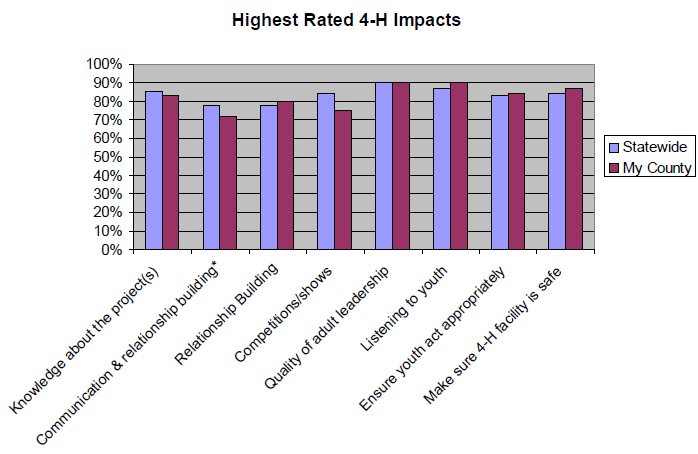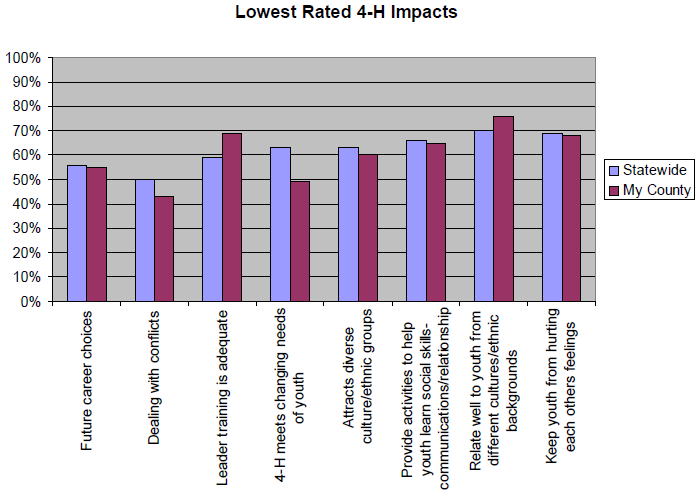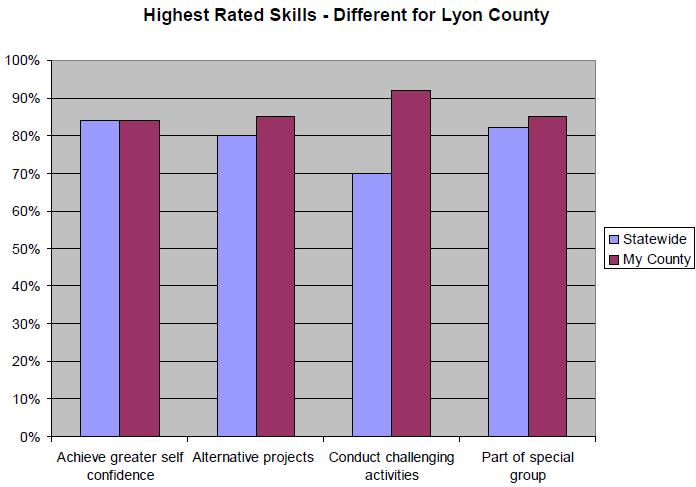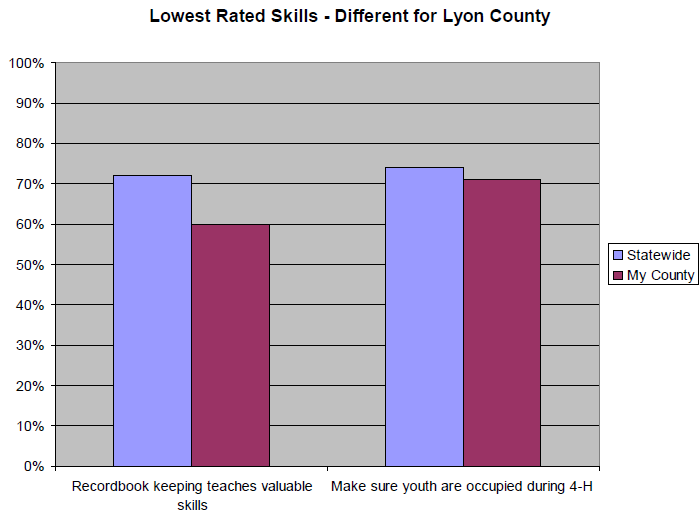Introduction
In continued efforts to assess 4-H program impacts, in 2003, University of Nevada Cooperative Extension surveyed all 4-H parents and leaders statewide. The results were sorted by county. Understanding impacts at the county level is important because 4-H programs in Nevada are managed at the county level. This fact sheet reports the impact assessment results statewide highlighting Lyon County. The purpose of this report is to inform 4-H parents, leaders and youth members how 4-H impacts their lives, and also assist 4-H professionals to develop an action plan to further strengthen Lyon County 4-H.
Designing and Conducting the Assessment
In designing a tool to assess 4-H program impacts, two models for youth development were used. The first model is based upon six outcomes to expect from successful youth development. These outcomes are confidence, competence, caring, connection, contributing, and character (Blyth, 2000).
Successful youth development helps children become: confident they can make a difference; competent through their ability, skills, and knowledge, and; able to work with people in a way that develops and promotes caring relationships. These youth connect beneficially with people and organizations, contribute their services to make a difference in their personal development as well as in their community, and demonstrate responsible and honest character, or a sense of who they are.
Another model for youth development used to develop the assessment questions focuses on “core concepts” and provide a basis for successful youth development programs in Nevada (UNCE, 1993). Such programs produce youth who:
- learn and practice self-responsibility and social responsibility to feel accountable and in control of their lives;
- recognize when and how to make informed decisions and implement decisions to solve a problem or achieve goals;
- communicate effectively in both verbal and written form, to share thoughts and feelings which increase social competence; and
- acquire career and occupational information to help prepare for the world of work. Questions developed for this assessment
were based upon the six desired outcomes of positive youth development and Nevada’s “core concepts” for teaching life skills. Combining models resulted in 9 questions to assess the effectiveness of 4-H in teaching youth life skills and 6 questions to assess social skills youth learn; 6 questions to measure the effectiveness of traditional 4-H teaching tools; and 4 questions to assess efficacy of program management goals.
In addition, 18 questions were developed specifically to assess parent and volunteer leader skills to teach youth, manage 4-H programs and prevent negative and high-risk behavior among 4- H youth. These questions were based on skills established by the National Committee on Community Programs to Promote Youth Development (Eccles and Gootman, 2002). These questions were designed to assess the indirect impacts of Nevada 4-H on parents and volunteer leaders.
Participants in the assessment included all parents and adult volunteer 4-H leaders currently enrolled in Lyon County. These participants were selected based on the rationale that 4-H leaders and parents of 4-Hers have the most frequent opportunity to observe any changes that occur among youth participating in 4-H programs.
Each individual was mailed a two-page questionnaire with instructions, and a selfaddressed and stamped return envelope. Also included was a cover letter that explained the purpose of the survey, ensured confidentiality to participants, and thanked them for their participation. Of the 3,074 surveyed statewide, 576 returned completed questionnaires resulting in a 19 percent response rate.
Statewide and County Impacts
On a scale of 1 to 5 with “1” being “very low” and “5” being “very high,” respondents were asked to circle the number that best indicates how effectively 4-H is developing youth and impacting adults involved. The results are presented by highest and lowest ratings. Results for Lyon County are presented alongside statewide impacts for comparison purposes.
The highest rated impacts are illustrated in Figure 1. Individual questions are listed below each bar graph to specify and illustrate the percentage responses for each question.
According to the assessment results the top life skill Lyon County youth learn is: Achieve great self-confidence around others. The highest rated social skill youth learn is: Communication and relationship building. In terms of 4-H teaching and program management goals, the highest rated impacts in Lyon County are: Alternative projects teach my child valuable skills and Quality of adult leadership is key to successful 4-H program. For 4-H parents and volunteer leaders, the highest rated parent and leader teaching skill is: Conduct activities that challenge youth; program management skill is Ensure youth feel they belong to a special group and feel an important part of 4-H program; and prevention skill is: Make sure that the facility where we 4-H activities is safe.
Figure 1

Data From Figure 1
Figure 2 illustrates areas to target for improvement in Lyon County 4-H. According to the assessment results, the lowest rated life skill Lyon County youth learn is: About future career choices. The lowest rated social skill youth learn is: Skills useful in dealing with conflicts. In terms of 4-H teaching and program management goals, the lowest rated impacts in Lyon County are: Record book keeping teaches valuable skills and 4-H meets the changing needs of youth. For 4-H parents and volunteer leaders, the lowest rated parent and leader teaching skill is: Provide activities to help youth learn social skills such as communication and relationship building; program management skill is Make sure youth are occupied during meetings; and prevention skill is: Keep youth from hurting each others feelings.
Figure 2

Data From Figure 2
Finally, Figure 3 illustrates highest rated impacts for Lyon County as compared with state impacts. For example, Lyon County and the state rated the highest life skill youth learn, Achieving greater self-confidence (84%). In contrast with state results, Lyon County rated highest teaching tool: Alternative projects teach valuable skills (85%). Highest rated parent and leader teaching skill in Lyon County is: Conduct activities that challenge youth (92%); and highest rated parent and leader management skill is: Help youth feel they belong to special group (85%) and Feel they are important part of 4-H program (85%). These examples illustrate the need to compare and contrast county results with statewide results.
Figure 3

Data From Figure 3
Lowest rated impacts for Lyon County as compared with statewide results only produced two differences (see Figure 4). The lowest rated 4-H teaching tool in Lyon County is: Record book keeping teaches valuable skills (60%) while the lowest rated parent and leader program management skill in Lyon County is: Making sure youth are occupied during 4-H meetings (71%).
Figure 4

Data From Figure 4
Developing an Action Plan to Strengthen Lyon County 4-H
To develop an action plan, Lyon 4-H professionals combined assessment results with available demographic information. Table 1 illustrates these demographics for Lyon County.
Table 1. Lyon County Demographics
| Category |
Amount |
| Number of school-age children in Lyon County |
7,268 |
| Total number of 4-H youth in Lyon County |
1,629 |
Ethnic distribution of children in Lyon County
(AI/AN) 5% (AS) <1% (H) 14% (B) 1% (W) 79% (O) <1% |
White (79%) |
Ethnic distribution of 4-H youth in Lyon County
(AI/AN) 4% (AS) 0% (H) 7% (B) 0% (W) 89% |
White (89%) |
| Median income of families in Lyon County |
44,200 |
| Income distribution of 4-H families in Lyon County |
10,000-199,999 |
| Percent 4-H families in Lyon County earning below $25,000 annually |
9.8% |
Next, the 4-H team listed a number of 4-H program conditions that describe the current situation. Does Lyon County 4-H reach youth that reflects the ethnic make-up of the county?
- We understand that we need to reach a more diverse audience – which means recruiting more children and adult volunteer leaders, but feel we are already at capacity in terms of our capabilities of managing our current youth program.
- Lyon County has five distinct communities, each one having distance from the other in both miles and needs.
- A positive program impact is the high percentage of youth that are touched by 4-H programming in non-traditional activities.
Within Lyon County the demographics present a challenge because there are five unique communities and limited staff to address community needs. The Lyon County 4-H team is collaborating with other youth groups in the county to present workshops and activities. Through this partnership all youths in Lyon County can benefit from 4-H youth educational programs even if they are not enrolled as traditional 4-H members. The team presents workshops to adults and youths in the “Just Kids” after-school program in Silver Springs, Fernley and Dayton and through the Boys and Girls Club of Mason Valley in Yerington.
One of the difficulties in working with a large program is conflict. This was rated low as a life skill for Lyon County. The 4-H team plans to consider how we currently deal with conflict and focus on developing skills and techniques to move into positive conflict resolution.
The resulting action plan for Lyon County 4-H includes the following three objectives:
- Training in conflict resolution for office staff, leaders, and parents.
- Modify the Commitment to Excellence contract to include issues of respecting privacy, awareness that actions and words can be hurtful and respecting others’ feelings.
- Initiate “I’m Committed to Excellence” training for all community clubs in Lyon County. Peer Educators from each community in Lyon County would teach this workshop. The training emphasizes Character Counts and Asset Building within the 4-H Community Clubs.
Conclusions
This fact sheet reported the results of the 2003 University of Nevada Cooperative Extension 4-H impact assessment comparing highest and lowest impacts for Lyon County with statewide results. According to the assessment results the top life skill Lyon County youth learn is achieving greater self-confidence around others. The highest rated social skill is relationship-building skills. In terms of 4-H teaching and program management goals, the highest rated impact in Lyon County is alternative 4-H projects, such as snowboarding and/or shooting sports, teach my child valuable skills. For 4-H parents and volunteer leaders, the highest rated parent and leader teaching skill is conducting activities with youth that are challenging to them; program management skill is the quality of adult leadership; and prevention skill is making sure the facility where we have 4-H is safe.
The lowest rated life skill Lyon County youth learn is: Learning about future career choices. The lowest rated social skill youth learn is: dealing with conflicts. In terms of 4-H teaching and program management goals, the lowest rated impact in Lyon County is 4-H meets the changing needs of youth. For 4-H parents and volunteer leaders, the lowest rated parent and leader teaching skill is: Provides activities to help youth learn social skills such as communication and relationship building; program management skill is: Making sure youth are occupied during 4-H meetings and activities; and prevention skill is: Keeping youth from hurting each others feelings.
Considering the survey results and conditions of Lyon County 4-H, the planning team decided in order to impact more youth, and yet continue to have high impacts overall, any strategy to strengthen 4-H must continue to move 4-H is a positive focused direction. Since conflict in Lyon County consumes a lot of professional staff time and energy, the priority program direction that emerged is to enhance life skills useful in dealing with conflicts.
This fact sheet is intended to inform 4-H parents, leaders and youth members how 4-H impacts their lives, and also assist Extension and 4-H professionals in developing an action plan to further strengthen Lyon County 4-H. Efforts are currently underway to develop action plans for most county programs in Nevada. The resulting action plans will serve as guidelines for strengthening 4-H in a positive, objective manner, and to continue to generate new ways in which 4-H can “make the best better.”
References
- Blyth, D. 2000. “Extension’s Roles in Community Youth Development for the 21rst Century,” The Center. Communication and Educational Technology Services, University of Minnesota Extension Service.
- Singletary, L. and M. Smith. 2004. Nevada 4-H Statewide Impact Assessment. Extension
Figure 1. Highest Rated 4-H Impacts
| Category |
Statewide |
My County |
| Knowledge about the project(s) |
85% |
83% |
| Communication & relationship building* |
78% |
72% |
| Relationship Building |
78% |
80% |
| Competitions/shows |
84% |
75% |
| Quality of adult leadership |
90% |
90% |
| Listening to youth |
87% |
90% |
| Ensure youth act appropriately |
83% |
84% |
| Make sure 4-H facility is safe |
84% |
87% |
Figure 2. Lowest Rated 4-H Impacts
| Category |
Statewide |
My County |
| Future career choices |
56% |
55% |
| Dealing with conflicts |
50% |
43% |
| Leader training is adequate |
58% |
69% |
| 4-H meets changing needs of youth |
63% |
49% |
| Attracts diverse culture/ethnic groups |
63% |
60% |
| Provide activities to help youth learn social skills communications/ relationship |
66% |
65% |
| Relate well to youth from different cultures/ethnic backgrounds |
70% |
77% |
| Keep youth from hurting each others feelings |
69% |
68% |
Figure 3. Highest Rated Skills - Different for Lyon County
| Category |
Statewide |
My County |
| Knowledge about the project(s) |
84% |
84% |
| Communication & relationship building* |
80% |
85% |
| Relationship Building |
70% |
92% |
| Competitions/shows |
82% |
85% |
Figure 4. Lowest Rated Skills - Different for Lyon County
| Category |
Statewide |
My County |
| Knowledge about the project(s) |
71% |
60% |
| Communication & relationship building* |
73% |
71% |


